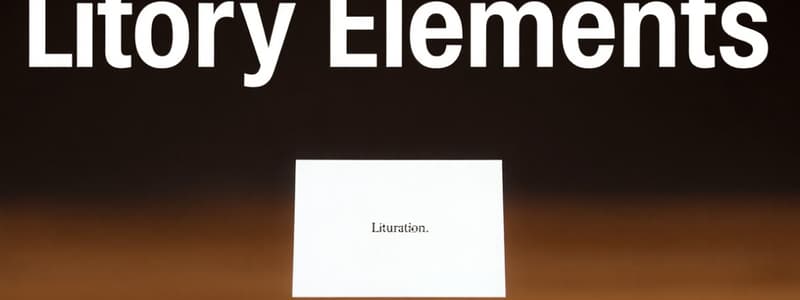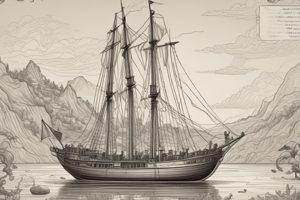Podcast
Questions and Answers
What is a characteristic of print materials?
What is a characteristic of print materials?
- They include audio and video resources.
- They are always visually appealing.
- They must convey distinct information to be useful. (correct)
- They consist only of textbooks.
Which of the following is a type of online material?
Which of the following is a type of online material?
- Podcasts (correct)
- Magazines
- Newspapers
- Textbooks
What is a key similarity between viewing materials and printed materials?
What is a key similarity between viewing materials and printed materials?
- Both contain themes and topics. (correct)
- Both are only delivered through the internet.
- Both must be physical objects.
- Both are produced in the same format.
What characteristic defines broadcast materials?
What characteristic defines broadcast materials?
What does accuracy refer to in the context of good information?
What does accuracy refer to in the context of good information?
Analytical listening is important because it involves:
Analytical listening is important because it involves:
Which of the following is NOT a feature of print materials?
Which of the following is NOT a feature of print materials?
What distinguishes online materials from print materials?
What distinguishes online materials from print materials?
What is the main purpose of an advance organizer?
What is the main purpose of an advance organizer?
Which type of advance organizer is designed to differentiate between old and new concepts?
Which type of advance organizer is designed to differentiate between old and new concepts?
Which type of speech involves delivering information without prior preparation?
Which type of speech involves delivering information without prior preparation?
What does a concept map illustrate?
What does a concept map illustrate?
What is the focus of skimming when reading?
What is the focus of skimming when reading?
Which advance organizer presents new information in a narrative format?
Which advance organizer presents new information in a narrative format?
Which of these is NOT a method of delivering a speech?
Which of these is NOT a method of delivering a speech?
An informative talk primarily aims to:
An informative talk primarily aims to:
What does completeness in information ensure?
What does completeness in information ensure?
Which aspect is NOT part of the common criteria in evaluating a text?
Which aspect is NOT part of the common criteria in evaluating a text?
In which stage of analytical listening does a listener generate meaning from what they have heard?
In which stage of analytical listening does a listener generate meaning from what they have heard?
Which WH question is NOT included in the solution framework for identifying problems?
Which WH question is NOT included in the solution framework for identifying problems?
What does consistency in information refer to?
What does consistency in information refer to?
Why is it necessary to have criteria when evaluating a text?
Why is it necessary to have criteria when evaluating a text?
What is the primary function of a news report?
What is the primary function of a news report?
What stage allows listeners to integrate what they have heard into their personal understanding?
What stage allows listeners to integrate what they have heard into their personal understanding?
Which part of a news report contains the most critical information?
Which part of a news report contains the most critical information?
What are textual aids primarily designed to do?
What are textual aids primarily designed to do?
Which of the following is NOT a component typically assessed during performance evaluations?
Which of the following is NOT a component typically assessed during performance evaluations?
What is the primary purpose of a Venn diagram?
What is the primary purpose of a Venn diagram?
Which of the following is NOT considered a textual aid?
Which of the following is NOT considered a textual aid?
What does the 'body' of a news report typically include?
What does the 'body' of a news report typically include?
Which statement best defines 'setting' in literature?
Which statement best defines 'setting' in literature?
What term describes visual elements that support understanding of a text?
What term describes visual elements that support understanding of a text?
What are major characters in a story?
What are major characters in a story?
What is conflict in a story?
What is conflict in a story?
What is an advance organizer?
What is an advance organizer?
Which of the following correctly lists parts of a news report?
Which of the following correctly lists parts of a news report?
Which of the following describes a sequence chart?
Which of the following describes a sequence chart?
What does the 'theme' of a story refer to?
What does the 'theme' of a story refer to?
How does a cause-and-effect diagram function in storytelling?
How does a cause-and-effect diagram function in storytelling?
What role do minor characters play in a story?
What role do minor characters play in a story?
Flashcards are hidden until you start studying
Study Notes
Venn Diagram
- A visual tool used to compare and contrast two or more items.
- Displays similarities and differences through overlapping circles.
Unity of Plot, Setting, and Characterization
- Essential story elements include plot, setting, characters, conflict, and theme.
Plot
- Refers to what happens in a story, including the sequential events from beginning to end.
Setting
- Defines the time and place of the story, significantly influencing its mood.
Characters
- Major characters are central to the story, while minor characters support and interact with them.
Cause-and-Effect Diagram
- Illustrates relationships and consequences in narratives, helping to visualize why events occur.
Conflict
- Represents the challenges within a story, categorized as internal (within a character) or external (between characters).
Theme
- The central idea or message of the story, providing insight into life or human experiences.
Print Materials
- Include all forms of written or printed resources excluding non-print, like books and magazines.
Online Materials
- Digital resources available on the internet, including documents, videos, and interactive content.
Broadcast Materials
- Learning resources transmitted via radio and television designed to inform, persuade, or entertain.
Analytical Listening
- Involves critical examination to discover details and derive meaning from sounds or messages.
Speech
- The skill of expressing thoughts articulately through spoken words, utilizing methods like manuscript or impromptu.
Informative Talks
- Speeches characterized by detailed descriptions and definitions aimed at educating the audience.
Advance Organizer
- A visual format designed to connect new information to prior knowledge or concepts.
T-Chart
- A graphic organizer that arranges ideas into two columns to compare two concepts effectively.
Textual Aids
- Visual elements such as charts and diagrams that enhance understanding and comprehension of content.
Completeness
- Information that answers all necessary questions and provides sufficient detail.
Consistency
- Ensures that information maintains a uniform quality over time.
Evaluating a Text
- Criteria for evaluation may include content accuracy, tone, word choice, mechanics, grammar, and cohesion.
Stages of Analytical Listening
- Receiving: Focus on auditory clarity.
- Understanding: Generate meaning from heard content.
- Evaluating: Analyze points presented.
- Responding: Provide feedback based on listening context.
- Remembering: Integrate and recall the heard information.
Criteria for Evaluating a Text
- Standards like vocal quality, stage presence, style, and overall performance to provide an objective assessment.
Studying That Suits You
Use AI to generate personalized quizzes and flashcards to suit your learning preferences.




